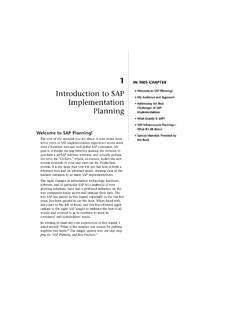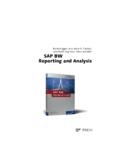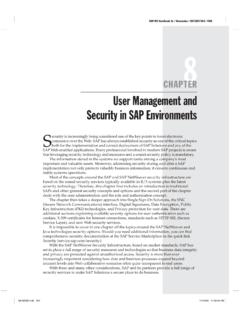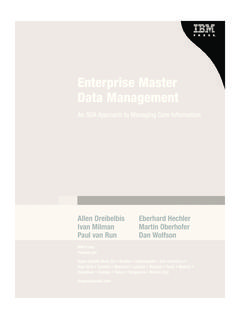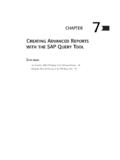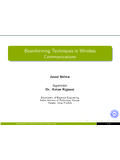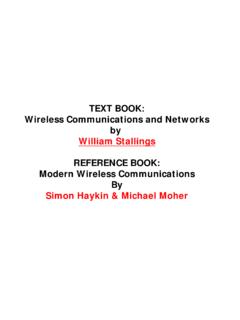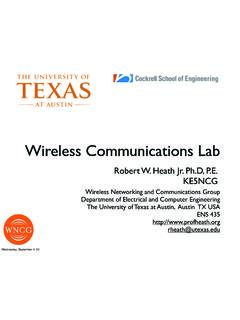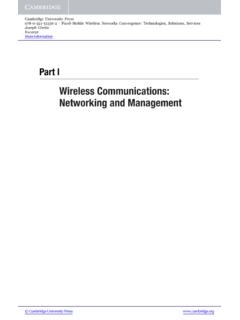Transcription of INTRODUCTION TO WIRELESS NETWORKS - …
1 2 INTRODUCTION TO WIRELESS NETWORKSUp to a point, it s quite possible to treat your WIRELESS network as a set of black boxes that you can turn on and use without knowing much about the way they work. That s the way most people relate to the technology that surrounds them. You shouldn t have to worry about the technical specifications just to place a long-distance telephone call or heat your lunch in a microwave oven or connect your laptop computer to a network . In an ideal world (ha!), the WIRELESS link would work as soon as you turn on the power WIRELESS networking today is about where broadcast radio was in the late 1920s. The technology was out there for everybody, but the people who understood what was happening behind that Bakelite-Dilecto panel (Figure 2-1) often got better performance than the ones who just expected to turn on the power switch and order to make the most effective use of WIRELESS networking tech-nology, it s still important to understand what s going on inside the box (or in this case, inside each of the boxes that make up the network ).
2 This 12 Chapter 2chapter describes the standards and specifications that control WIRELESS NETWORKS and explains how data moves through the network from one computer to 2-1: Every new technology goes through the tweak-and-fiddle the network is working properly, you should be able to use it with-out thinking about all of that internal plumbing just click a few icons and you re connected. But when you re designing and building a new network , or when you want to improve the performance of an existing network , it can be essential to understand how all that data is supposed to move from one place to another. And when the network does something you aren t expecting it to do, you will need a basic knowledge of the technology to do any kind of useful WIRELESS NETWORKS WorkMoving data through a WIRELESS network involves three separate elements: the radio signals, the data format, and the network structure.
3 Each of these elements is independent of the other two, so you must define all three INTRODUCTION to WIRELESS Networks13when you invent a new network . In terms of the OSI reference model, the radio signal operates at the physical layer, and the data format controls several of the higher layers. The network structure includes the WIRELESS network interface adapters and base stations that send and receive the radio signals. In a WIRELESS network , the network interface adapters in each computer and base station convert digital data to radio signals, which they transmit to other devices on the same network , and they receive and convert incoming radio signals from other network elements back to digital data. Each of the broadband WIRELESS data services use a different combination of radio signals, data formats, and network structure.
4 We ll describe each type of WIRELESS data network in more detail later in this chapter, but first, it s valuable to understand some general basic physical laws that make radio possible are known as Maxwell s equations, identified by James Clerk Maxwell in 1864. Without going into the math, Maxwell s equations show that a changing magnetic field will produce an electric field, and a changing electric field will produce a magnetic field. When alternating current (AC) moves through a wire or other physical conductor, some of that energy escapes into the surrounding space as an alternating magnetic field. That magnetic field creates an alternating electric field in space, which in turn creates another magnetic field and so forth until the original current is form of energy in transition between electricity and magnetic energy is called electromagnetic radiation, or radio waves.
5 Radio is defined as the radiation of electromagnetic energy through space. A device that produces radio waves is called a transmitter, and a complementary device that detects radio waves in the air and converts them to some other form of energy is called a receiver. Both transmitters and receivers use specially shaped devices called antennas to focus the radio signal in a particular direction, or pattern, and to increase the amount of effective radiation (from a transmitter) or sensitivity (in a receiver).By adjusting the rate at which alternating current flows from each trans-mitter through the antenna and out into space (the frequency), and by adjusting a receiver to operate only at that frequency, it s possible to send and receive many different signals, each at a different frequency, that don t interfere with one another.
6 The overall range of frequencies is known as the radio spectrum. A smaller segment of the radio spectrum is often called a frequencies and other AC signals are expressed as cycles per second, or hertz (Hz), named for Heinrich Hertz, the first experimenter to send and receive radio waves. One cycle is the distance from the peak of an AC signal to the peak of the next signal. Radio signals generally operate at frequencies in thousands, millions, or billions of hertz (kilohertz or KHz, megahertz or MHz, and gigahertz or GHz, respectively).The simplest type of radio communication uses a continuous signal that the operator of the transmitter interrupts to divide the signal into accepted patterns of long and short signals (dots and dashes) that correspond to 14 Chapter 2individual letters and other characters. The most widely used set of these patterns was Morse code, named for the inventor of the telegraph, Samuel Morse, where this code was first used.
7 In order to transmit speech, music, and other sounds via radio, the trans-mitter alters, or modulates, the AC signal (the carrier wave) by either mixing an audio signal with the carrier as shown in Figure 2-2 (this is called amplitude modulation, or AM) or by modulating the frequency within a narrow range as shown in Figure 2-3 (this is called frequency modulation, or FM). The AM or FM receiver includes a complementary circuit that separates the carrier from the modulating 2-2: In an AM signal, the audio modulates the 2-3: In an FM signal, the audio modulates the radio two or more radio signals using the same frequency can often interfere with one another, government regulators and international agencies, such as the International Telecommunication Union (ITU), have reserved certain frequencies for specific types of modulation, and they issue exclusive licenses to individual users.
8 For example, an FM radio station might be licensed to operate at MHz at a certain geographical location. Nobody else is allowed to use that frequency in close enough proximity to interfere with that signal. On the other hand, some radio services don t require a license. Most unlicensed services are either restricted to very short distances, to specific frequency bands, or both. Both AM and FM are analog methods because the signal that comes out of the receiver is a replica of the signal that went into the transmitter. When we send computer data through a radio link, it s digital because the content has been converted from text, computer code, sounds, images or other infor-mation into ones and zeroes before it is transmitted, and it is converted back to its original form after it is received. Digital radio can use any of several different modulation methods: The ones and zeroes can be two different audio tones, two different radio frequencies, timed interruptions to the carrier, or some combination of those and other to WIRELESS Networks15 WIRELESS Data NetworksEach type of WIRELESS data network operates on a specific set of radio fre-quencies.
9 For example, most Wi-Fi NETWORKS operate in a special band of radio frequencies around GHz that have been reserved in most parts of the world for unlicensed point-to-point spread spectrum radio services. Other Wi-Fi systems use a different unlicensed band around 5 GHz. Unlicensed Radio ServicesUnlicensed means that anybody using equipment that complies with the tech-nical requirements can send and receive radio signals on these frequencies without a radio station license. Unlike most radio services (including other broadband WIRELESS services), which require licenses that grant exclusive use of that frequency to a specific type of service and to one or more specific users, an unlicensed service is a free-for-all where everybody has an equal claim to the same airwaves. In theory, the technology of spread spectrum radio makes it possible for many users to co-exist (up to a point) without significant point-to-point radio service operates a communication channel that carries information from a transmitter to a single receiver.
10 The opposite of point-to-point is a broadcast service (such as a radio or television station) that sends the same signal to many receivers at the same SpectrumSpread spectrum is a family of methods for transmitting a single radio signal using a relatively wide segment of the radio spectrum. WIRELESS Ethernet NETWORKS use several different spread spectrum radio transmission systems, which are called frequency-hopping spread spectrum (FHSS), direct-sequence spread spectrum (DSSS), and orthogonal frequency division multiplexing (OFDM). Some older data NETWORKS use the slower FHSS system, but the first Wi-Fi NETWORKS used DSSS, and more recent systems use OFDM. Table 2-1 lists each of the Wi-Fi standards and the type of spread spectrum modulation they spectrum radio offers some important advantages over other types of radio signals that use a single narrow channel.


